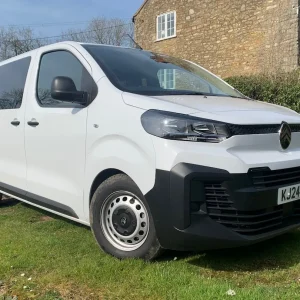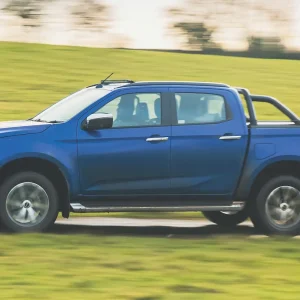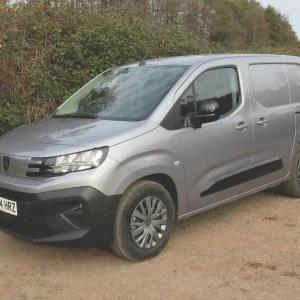Today's made-in-Oxford Mini Clubvan boasts equipment, performance levels and a general air of refinement that owners of its predecessor could only have dreamt about. It is, however, unlikely to be seen in the livery of big fleet users any time soon. That's because Mini is aiming it at niche markets, a policy the brand has executed to near-perfection with its car line-up. This classy vehicle will be the runabout of choice for high-class retailers in Chelsea and upmarket estate agents in Bath, particularly because the price-tag is on the steep side, although the manufacturer argues that the residual value and amount of standard kit is higher than that offered by the competition.
Cabin
While the huge speedometer smack in the middle of the dashboard may be reminiscent of the old Mini, that's where the resemblance between the interiors of the old and new models ends. Today's speedometer also acts as a display for everything from the optional satnav – where fitted – to the onboard computer, while a separate rev counter above the steering column incorporates an additional, digital, speed display.
Identical to the Clubman car on which this van is based, small, neat, toggle-style switches on the dash are used to raise and lower the windows and lock all the doors. Storage facilities include a deep lidded glove box and door pockets, and you'll find a couple of cup-holders at the bottom of the fascia.
The driver's seat is height- adjustable and the steering wheel can be altered for reach and rake.
Our test Cooper D Clubvan turned up with optional, and really comfortable, Sports front seats for an extra £183 (all prices quoted here exclude VAT) both of which were heated for a further £179 and during a prolonged winter were necessary even though the heating works well. Clearly noticeable were the Leather Punch and Chrome Line interior trim packages at an additional £942 and £92 respectively.
Our Mini’s predominantly black interior, while attractive, felt a little claustrophobic at times. On the positive side, though, the cab offers plenty of leg space.
Load area
In traditional Mini Van style, rear access to the 0.9m3 cargo area is by means of twin side-hinged doors. But in a key departure from the old model, access can also be gained by means of a so-called Clubdoor – more like a hinged flap than a proper door – on the vehicle's offside adjacent to the driver's door. It’s because the Clubman passenger car was built to favour the majority of markets that are left-hand drive, so the fuel tank gets in the way of any attempt to switch the door around for the UK. It’s a shame, as if only one side cargo area door is fitted to a van then it should always be on the nearside of a right-hand drive vehicle for both convenience and safety. Not that operators will use it all that often: it allows you to get your hand into the load area and pull out small items, but that's about all.
The three doors give access to a load box that is 1150mm long, 840mm high and 1090mm wide narrowing to 1025mm. There is no wheel-box intrusion. Rear loading height is 660mm and the rear door aperture is 990mm wide and 635mm high.
Top payload is 500kg and the flat load bed features half-a-dozen cargo tie-down points. A full-width half-height aluminium bulkhead is fitted, topped off by a full-width steel mesh grille extending to the roof.
The bed and the cargo box's sides are protected from minor scratches and scrapes by carpeting, although it could be difficult to keep clean if messy loads have to be carried. That said, Mini Clubvan owners probably wouldn't be in the business of transporting grubby cargo.
The headlining extends all the way back to the rear doors, which helps keep the vehicle warmer and quieter and lessens the risk of condensation forming and dripping. Tinted glass in the back doors, blocked-out body-coloured rear side windows reinforced with polycarbonate, and the aforementioned bulkhead and grille should makes the lives of thieves more difficult, and we applaud the provision of two 12V power points.
With its 2547mm wheelbase and Clubman platform, the Clubvan is 3961mm long, 1683mm wide – 1913mm if you include the door mirrors – and 1426mm high. If there is not enough space in the load box then there is the option to equip the standard roof rails with a ladder rack.
The van has a gross weight of 1685kg and can haul a braked trailer grossing at up to 750kg.
Powertrain
Customers can pick from three models, two of which are petrol at 98hp (One Clubvan) and 122hp (Cooper Clubvan).
Our demonstrator was powered by the third choice: a Euro5 112hp 1.6-litre four-cylinder diesel with a particulate filter. Maximum power kicks in at 4000rpm, top torque of 270Nm bites across a 1750- 2250rpm plateau and the engine is married to a six-speed manual gearbox. A six-speed auto box is offered as an option.
Included in the deal are what Mini refers to as Minimalism features, including automatic stop/start and Brake Energy Regeneration, which uses a display on the dashboard to advise when to change gear for optimum fuel economy.
You fire up the engine not with an ignition key but by pushing a fob, which also plays host to the remote central locking switches, into a slot on the dashboard then pressing the starter button.
Chassis and steering
The front-wheel drive Clubvan's front suspension employs MacPherson struts, the rear suspension makes use of a multi-link set-up, and the little van usually sits on 15-inch Delta Spoke light alloy wheels shod with 175/65 R15 tyres. Buyers can specify 15-, 16, and 17-inch alloys made to alternative designs if they wish, but our demonstrator came with black 17-inch Conical Spoke alloys with Continental ContiSport Contact 3 low-profile 205/45/R17 tyres for an extra £942. Electric power-assisted steering is a standard feature.
Performance
With sharp handling, responsive steering and a smooth gear- change, the highly manoeuvrable little Clubvan is a real joy to drive. There is plenty of torque right down in the rev band that helps it accelerate strongly and it is an impressive motorway cruiser with low engine noise levels, although that last facet increases the danger that you will start to creep up above 70mph without realising it.
On the downside, the suspension seemed at times to struggle with Britain's imperfect road surfaces – the low-profile tyres probably didn't help – and we noted rather too much tyre noise on occasions.
Equipment
Standard equipment includes electric windows, electrically adjustable exterior mirrors – for an extra £33 you can have them heated along with the windscreen washer jets – and a DAB digital radio/CD player with an aux-in socket.
Our demonstrator featured an optional £813 Pepper pack, which includes automatic aircon (manual aircon comes as standard), front fog-lights, a leather-trimmed steering wheel, an onboard computer, height-adjustment for the passenger seat, and wipers and lights that come on automatically depending on the weather and prevailing light conditions. In addition we benefitted from a Media pack that embraces full Bluetooth preparation, voice control and satellite navigation among other extras for £1117.
Buying and running
While the Clubvan is not cheap, especially if you start adding all the goodies on the options list, fuel economy, on paper at least, looks impressive. Official figures state an average 64.2mpg on the urban cycle, 78.5mpg on the extra-urban cycle and 72.4mpg on the combined cycle. However, on our test run, which involved a variety of different types of road, we only managed 46mpg, admittedly in a van that had been barely run in, was at times being pushed quite hard, and was lightly laden. Official CO2 output, meanwhile, is an environmentally acceptable 103g/km, and residual values will be string thanks to the brand and relatively low numbers.
The Clubvan is covered by a three-year/unlimited-mileage warranty and service intervals are variable depending on the use to which the van is put. It may typically require a workshop visit once every 16,000-18,000 miles. Its insurance group is 3E.
Safety
Disc brakes – ventilated at the front – are fitted to all four wheels and the van comes with the usual list of safety features that most new vans boast these days. Included in the package are ABS, EBD (Electronic Brakeforce Distribution), CBC (Cornering Brake Control) and DSC (Dynamic Stability Control). The last named is intended to prevent the Clubvan turning over if the driver has to swerve suddenly on a wet or icy road.
Half-a-dozen airbags are installed as is a Thatcham Category 1 alarm and immobiliser plus a tyre pressure warning system. Remote central locking is fitted and all the doors lock automatically at above 10mph. Finally, a rear parking aid, costing £204, was also installed on our van.
The first 22 years of light commercial life
Launched in January 1960, the original Mini Van debuted with an 848cc petrol engine and a miniscule 250kg payload capacity. With a wheelbase 100mm longer than the saloon it swiftly proved popular, not just with small businesses but also with fleet operators such as the AA. 
The little load lugger was followed by a pick-up exactly a year later and by the Mini Moke in August 1964, familiar to anybody who has ever watched the cult 1960s TV show The Prisoner.
The Mini Van received a slow but steady series of improvements over the years, including the arrival of a 998cc petrol engine as an option in October 1967. December 1978 saw the use of a
95 badge as an indication of the vehicle's modest 950kg gross weight.
Almost 580,000 vans and pick-ups had been built by the time production of both model line-ups ceased in December 1982.





